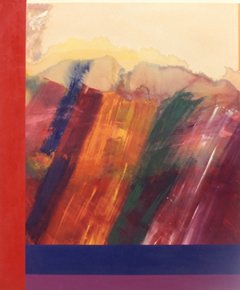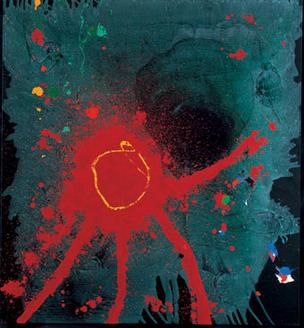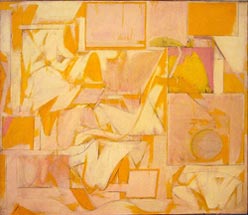
Kenneth Noland was an American painter. He was one of the best-known American color field painters, although in the 1950s he was thought of as an abstract expressionist and in the early 1960s he was thought of as a minimalist painter. Noland helped establish the Washington Color School movement. In 1977, he was honored by a major retrospective at the Solomon R. Guggenheim Museum in New York that then traveled to the Hirshhorn Museum and Sculpture Garden in Washington, D.C. and Ohio's Toledo Museum of Art in 1978. In 2006, Noland's Stripe Paintings were exhibited at the Tate in London.

Samuel Lewis Francis was an American painter and printmaker.

Hard-edge painting is painting in which abrupt transitions are found between color areas. Color areas are often of one unvarying color. The Hard-edge painting style is related to Geometric abstraction, Op Art, Post-painterly Abstraction, and Color Field painting.

Monochromatic painting has played a significant role in modern and contemporary Western visual art, originating with the early 20th-century European avant-gardes. Artists have explored the non-representational potential of a single color, investigating shifts in value, diversity of texture, and formal nuances as a means of emotional expression, visual investigation into the inherent properties of painting, as well as a starting point for conceptual works. Ranging from geometric abstraction in a variety of mediums to non-representational gestural painting, monochromatic works continue to be an important influence in contemporary art.

Color field painting is a style of abstract painting that emerged in New York City during the 1940s and 1950s. It was inspired by European modernism and closely related to abstract expressionism, while many of its notable early proponents were among the pioneering abstract expressionists. Color field is characterized primarily by large fields of flat, solid color spread across or stained into the canvas creating areas of unbroken surface and a flat picture plane. The movement places less emphasis on gesture, brushstrokes and action in favor of an overall consistency of form and process. In color field painting "color is freed from objective context and becomes the subject in itself."

Shaped canvases are paintings that depart from the normal flat, rectangular configuration. Canvases may be shaped by altering their outline, while retaining their flatness. An ancient, traditional example is the tondo, a painting on a round panel or canvas: Raphael, as well as some other Renaissance painters, sometimes chose this format for madonna paintings. Alternatively, canvases may be altered by losing their flatness and assuming a three-dimensional surface. Or, they can do both. That is, they can assume shapes other than rectangles, and also have surface features that are three-dimensional. Arguably, changing the surface configuration of the painting transforms it into a sculpture. But shaped canvases are generally considered paintings.

Ellsworth Kelly was an American painter, sculptor, and printmaker associated with hard-edge painting, Color Field painting and minimalism. His works demonstrate unassuming techniques emphasizing line, color and form, similar to the work of John McLaughlin and Kenneth Noland. Kelly often employed bright colors. He lived and worked in Spencertown, New York.

Ronnie Landfield is an American abstract painter. During his early career from the mid-1960s through the 1970s his paintings were associated with Lyrical Abstraction, and he was represented by the David Whitney Gallery and the André Emmerich Gallery.

Lyrical abstraction is either of two related but distinct trends in Post-war Modernist painting:

Ronald "Ron" Davis is an American painter whose work is associated with geometric abstraction, abstract illusionism, lyrical abstraction, hard-edge painting, shaped canvas painting, color field painting, and 3D computer graphics. He is a veteran of nearly seventy solo exhibitions and hundreds of group exhibitions.
Walter Darby Bannard was an American abstract painter and professor of art and art history at the University of Miami.

Karl Stanley Benjamin was an American painter of vibrant geometric abstractions, who rose to fame in 1959 as one of four Los Angeles-based Abstract Classicists and subsequently produced a critically acclaimed body of work that explores a vast array of color relationships. Working quietly at his home in Claremont, CA, he developed a rich vocabulary of colors and hard-edge shapes in masterful compositions of tightly balanced repose or high-spirited energy. At once intuitive and systematic, the artist was, in the words of critic Christopher Knight, "a colorist of great wit and inventiveness."

20th-century Western painting begins with the heritage of late-19th-century painters Vincent van Gogh, Paul Cézanne, Paul Gauguin, Georges Seurat, Henri de Toulouse-Lautrec, and others who were essential for the development of modern art. At the beginning of the 20th century, Henri Matisse and several other young artists including the pre-cubist Georges Braque, André Derain, Raoul Dufy and Maurice de Vlaminck, revolutionized the Paris art world with "wild", multi-colored, expressive landscapes and figure paintings that the critics called Fauvism. Matisse's second version of The Dance signified a key point in his career and in the development of modern painting. It reflected Matisse's incipient fascination with primitive art: the intense warm color of the figures against the cool blue-green background and the rhythmical succession of the dancing nudes convey the feelings of emotional liberation and hedonism.
Leo Valledor (1936–1989) was a Filipino-American painter who pioneered the hard-edge painting style. During the 1960s he was a member of the Park Place Gallery in Soho, New York City, which exhibited many influential and significant artists of the period. He was a leader of the minimalist movement in the 1970s.
Neil Williams was an American painter. Williams was an abstract painter primarily known for his pioneering work with shaped canvases in the early 1960s. His paintings of the 1960s, 1970s and 1980s are associated with geometric abstraction, hard-edge painting, color field, and lyrical abstraction, although he did not readily subscribe to any category for his work. He taught Fine Arts at the School of Visual Arts from the late 1970s until the early 1980s.
Post-painterly abstraction is a term created by art critic Clement Greenberg as the title for an exhibit he curated for the Los Angeles County Museum of Art in 1964, which subsequently travelled to the Walker Art Center and the Art Gallery of Toronto.
Alvin D. Loving Jr., better known as Al Loving, was an African-American abstract expressionist painter. His work is known for hard-edge abstraction, fabric constructions, and large paper collages, all exploring complicated color relationships.

Harvey Quaytman was a geometric abstraction painter best known for large modernist canvases with powerful monochromatic tones, in layered compositions, often with hard edges - inspired by Malevich and Mondrian. He had more than 60 solo exhibitions in his career, and his works are held in the collections of many top public museums.
David Simpson is an American abstract painter who lives and works in Berkeley, California. In 1956 Simpson graduated from the California School of Fine Arts with a BFA; and in 1958 he earned an MFA, from the San Francisco State College. Since 1958 Simpson has had more than 70 solo exhibitions of his paintings in galleries and museums worldwide. His paintings have been included in hundreds of group exhibitions throughout the United States and Europe. During the early 1960s Simpson was included in two seminal group exhibitions: Americans 1963 at the Museum of Modern Art in New York curated by Dorothy Canning Miller and Post-Painterly Abstraction curated by Clement Greenberg in 1964; that traveled to the Los Angeles County Museum of Art the Walker Art Center and the Art Gallery of Toronto.
Joe Doyle was an American artist. He is one of the original painters in the style, abstract illusionism, of the 1970s and has since evolved his style using computerized technologies to create Digital art.















